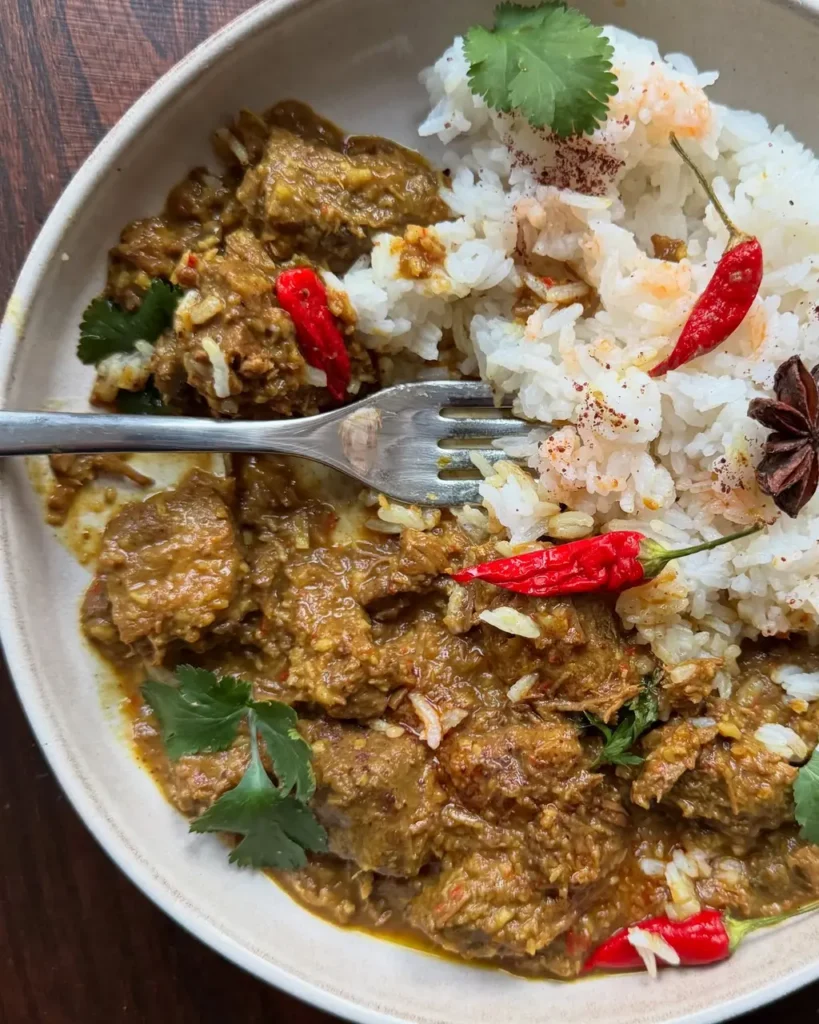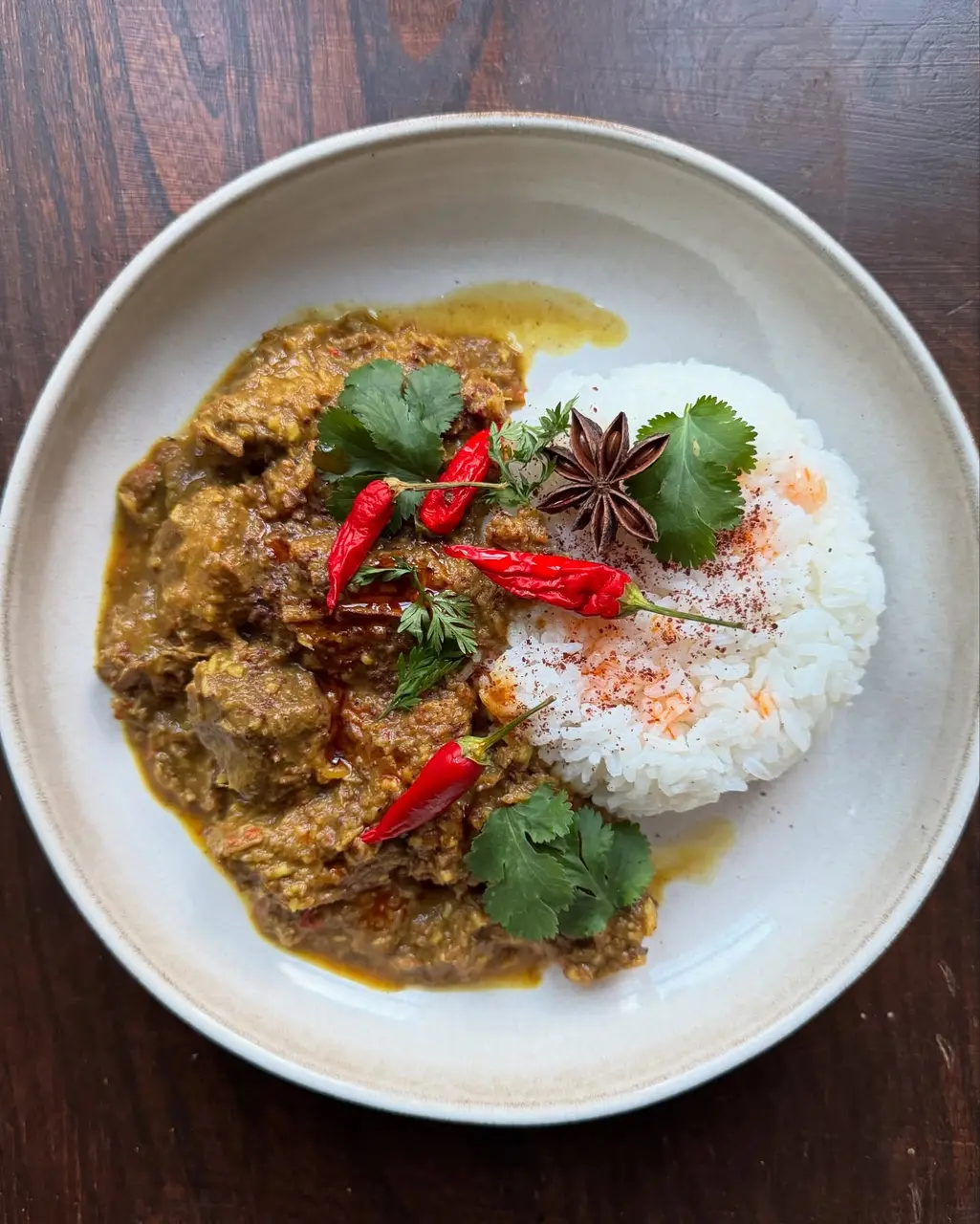This version of beef rendang is all about deep, concentrated flavor built from a toasted, fragrant spice paste and slow, patient cooking.
The result is melt-tender beef cloaked in a glossy, caramelized coconut sauce that’s intensely savory and slightly sweet.
Think of it as a show-stopping, freezer-friendly dinner that actually tastes better on day two.
It’s the kind of curry you’ll want to make when you have a little time and a lot of appetite.
Why this rendition stands out

We focus on layering technique rather than shortcutting complexity.
Toasting and lightly frying the paste unlocks oils and deep aromatics you’ll taste in every bite.
Slow, gentle braising concentrates the coconut and spices until the sauce clings to the meat like a lacquer.
That long reduction also gives you that signature slightly sticky, almost jammy finish rendang is known for.
Ingredients you’ll need
Start with good, chunky pieces of beef — braising cuts like chuck, shin, or brisket are perfect.
Coconut milk and a splash of water create the cooking liquid that reduces down to a silky, coconut-spiced sauce.
A handful of aromatics — lemongrass, ginger, garlic, and shallot or onion — form the backbone of the spice paste.
Warm, toasted spices like ground coriander, cumin, and turmeric bring earthiness and color.
Add whole aromatics such as cinnamon stick and star anise to perfume the pot while it simmers.
A little toasted desiccated coconut folded in during cooking helps thicken and deepen the final sauce.
For a balanced finish, a touch of sugar and a splash of savory seasoning round out the profile.
Steamed jasmine rice and fresh herbs make simple, perfect partners for serving.
Building the spice paste — the flavor foundation

First, rough-chop your aromatics so your blender can do the heavy lifting.
Lemongrass should be trimmed to the tender white sections and chopped to help get a smooth paste.
Toast ground coriander and cumin briefly in a dry pan to wake up their oils and increase depth.
Then blitz toasted spices, fresh aromatics, chillies, ginger, garlic, and onion into a smooth, fragrant paste.
Cook the paste slowly in a wide pot with oil until the raw, bright edge disappears.
You’re aiming for caramelized edges and a glossy sheen — this takes time but it’s where the flavor builds.
Browning the beef and layering flavors
After the paste is richly browned, add the beef so each chunk gets coated and slightly seared.
Searing isn’t about creating a crust so much as sealing the meat and beginning Maillard flavor in the spice coating.
Pour in coconut milk and a little water to just cover the meat and add whole aromatics like kaffir lime leaves if you have them.
The pot should go from bubbling gently to low and steady — if it’s too vigorous, the sauce won’t reduce properly.
Toast a small handful of desiccated coconut separately until golden and add it to the pot.
This toasted coconut adds nuttiness and helps the sauce thicken as it breaks down during the long cook.
Low and slow — the braise that makes rendang special
Transfer the covered pot to a low oven or keep it on the stovetop on a low heat for a long, slow braise.
This gentle, consistent heat is what allows connective tissue to dissolve into unctuous, fork-tender meat.
Plan for a minimum of two hours covered and another hour uncovered to let the sauce reduce and caramelize.
Check occasionally to stir and prevent catching, and adjust the liquid with small splashes of water if it’s evaporating unevenly.
As the sauce reduces, the color will deepen and the texture will go from soupy to thick and glossy.
Finish with the last adjustments: a little sweetener to balance, plus savory seasoning to taste.
Finishing touches and presentation

Once the sauce has reduced to a lacquered thickness, fish out visible whole spices like the cinnamon stick and star anise.
A scatter of chopped coriander or kaffir lime leaves brightens the plate at the end.
Serve your rendang with steaming jasmine rice so each spoonful can scoop up that concentrated sauce.
For a contrast in texture, add a quick cucumber salad or a side of crisp greens.
If you want a different pairing, this rendang also plays well with pillowy flatbreads such as homemade puffy pita for dipping.
You could also pair it with garlic butter shrimp for a surf-and-turf dinner experience.
Variations and ingredient swaps
If you like heat, keep the seeds in some of the red chilies and add them to the paste.
To make it milder, opt for fewer chilies and add a pinch of smoked paprika for warmth without heat.
Swap palm sugar for good dark brown sugar if that’s what you have at hand.
If you don’t have kaffir lime leaves, a little lime zest added at the end lifts the aroma nicely.
For a richer sauce, use a can of full-fat coconut cream in place of some of the coconut milk.
Vegetarian or plant-based eaters can use jackfruit or large mushrooms and reduce cook time accordingly.
Time-saving options and make-ahead strategy
Make the spice paste a day or two ahead and refrigerate it; it keeps beautifully for 48 hours and saves prep time.
The rendang also freezes exceptionally well — portion into airtight containers and freeze for up to three months.
Reheat gently on low heat with a splash of water to loosen the sauce without losing its sheen.
This makes it an ideal meal to batch-cook and pull from the freezer for busy weeknights.
Textures, temperature, and the science behind the gloss

The glossy, sticky finish comes from reducing the coconut milk until the natural fats and sugars concentrate.
Toasting the desiccated coconut accelerates those nutty, caramelized notes that help create thickness.
Slow collagen breakdown in braising cuts turns chewy fibers into soft, buttery threads.
This is why the choice of cut and the length of the braise matter more than any quick sear.
Troubleshooting common issues
If your sauce is too thin after an hour, remove the lid and increase the heat slightly to encourage reduction.
If the meat is still tough, continue braising low and slow — it will become tender once the connective tissue fully breaks down.
If the sauce tastes flat, test for acid, sweet, and salt balance, and correct with a squeeze of lime, a touch more sugar, or a pinch of salt.
If it’s overly salty, add a peeled, halved potato to absorb some salt and discard it before serving.
Serving suggestions and side pairings
Accompany with steamed jasmine rice for a classic presentation that soaks up the sauce.
A simple, crisp cucumber salad with rice vinegar and a pinch of sugar cuts through richness.
For a more substantial spread, add lightly sautéed greens or a bowl of coconut rice for extra coconut fragrance.
If you like playful menu combos, match with creamy peanut lime noodles as a contrasting option.
Storage, reheating, and make-ahead tips
Cool rendang to room temperature before refrigerating to keep the texture intact.
Store in a sealed container for up to four days in the fridge.
Reheat slowly over low heat with a tablespoon of water to loosen the sauce, stirring until glossy again.
For frozen portions, thaw overnight in the refrigerator before reheating gently.
Final thoughts before you cook
Beef rendang rewards patience and attention more than technical finesse.
Take the extra time to brown the paste and let the sauce reduce — the payoff is depth of flavor that taste testers will notice.
This one-pot approach keeps cleanup manageable and your kitchen smelling like a spice shop for hours.
Leftovers transform into an even richer experience, so make extra intentionally and enjoy the gifts of daily reheating.
Frequently Asked Questions (FAQ)
What cut of beef works best for rendang?
Braising cuts like chuck, shin, or brisket are best because they become tender and flavorful over a long cook.
Avoid lean steaks that will dry out and lack the gelatin that makes rendang silky.
Can I use store-bought curry paste instead of making the spice paste?
You can, but fresh-made paste gives a brighter, more complex flavor that paste from a jar rarely matches.
If using store paste, boost it with freshly toasted ground spices and a thumb of grated ginger.
How long should I braise the rendang?
Aim for around three hours total — two hours covered and an hour uncovered to reduce.
Check for fork-tender beef and a thick, glossy sauce before finishing.
Is rendang freezer-friendly?
Yes, it freezes very well in portions for up to three months.
Thaw in the fridge overnight and reheat gently for best texture.
Do I need to use kaffir lime leaves and desiccated coconut?
Kaffir lime leaves add a bright, citrusy perfume, and toasted desiccated coconut helps thicken and color the sauce.
If you don’t have them, small substitutions like lime zest and a bit of browned shredded coconut will work.
Can I make a quicker, stovetop version?
You can reduce time slightly by simmering on the stove instead of using the oven, but maintain low heat and patience.
Rushing the cook will give you a less concentrated sauce and tougher meat.
Is this recipe spicy?
Spiciness depends on the chilies you use and whether you keep the seeds.
Adjust quantity and type of chilies to match your family’s palate.
Where can I find more recipes to pair with rendang?
Consider soft flatbreads or simple vegetable sides for contrast, and check out complementary recipes like homemade puffy pita or garlic butter shrimp for varied menus.
For noodles, creamy peanut lime noodles work beautifully.
Enjoy the process and the steadily deepening aroma as your kitchen turns into a small Malay feast.
This slow-cooked beef rendang is a dish built for sharing, leftovers, and the satisfaction that comes from true home cooking.

Slow-Cooked Beef Rendang – Rich Malay Coconut Curry
Ingredients
Method
- Preheat the oven to 150°C (300°F). Blend all the spice paste ingredients in a food processor until smooth. Add a little water if needed to help blend.
- Heat 2 tbsp of oil in a large deep saucepan. Add the spice paste and cook for 7 minutes until fragrant and deepened in color.
- Add the beef chunks to the paste and stir to coat. Cook for 5 minutes until the beef is lightly browned.
- Pour in the coconut milk and water, then add the kaffir lime leaves, cinnamon stick, star anise, and toasted desiccated coconut.
- Bring to a gentle simmer, then cover and transfer to the oven for 2 hours.
- Uncover and cook for another hour until the sauce is thick and reduced.
- Stir in brown sugar, soy sauce, and fish sauce. Remove the cinnamon stick and star anise.
- Serve hot with steamed jasmine rice and garnish with fresh coriander.
Notes
- This rendang tastes even better the next day as flavors deepen.
- Store in the fridge for up to 4 days or freeze portions for up to 3 months.


Leave a Reply